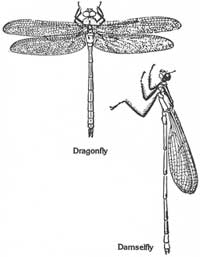Odonata: Dragonflies and Damselflies
(from the Greek: odontos = tooth)
Odonata are medium- to large-sized insects with bristle-like antennae, chewing mouthparts, and 2 pairs of membranous wings. The  front and hind wings are of equal length with many cross-veins. The abdomen is long and narrow. In some dragonflies, the abdomen tapers to a point like a long fang, or tooth, which suggested the scientific name for the order. Immature Odonata are underwater predators. They are fully aquatic, complete with gills.
front and hind wings are of equal length with many cross-veins. The abdomen is long and narrow. In some dragonflies, the abdomen tapers to a point like a long fang, or tooth, which suggested the scientific name for the order. Immature Odonata are underwater predators. They are fully aquatic, complete with gills.
There are two main groups of Odonata: the damselflies and the dragonflies. Damselflies are weak fliers and are found along the banks of streams and ponds. Their wings are narrow at the bases. Dragonflies are strong fliers, and often range long distances from water. They can hover and quickly change direction when in full flight. Although dragonflies are common, they are some of the most difficult insects to capture in an insect net.
Because Odonata are predaceous on other insects, they are considered beneficial. Sometimes, dragonflies are pests when they capture commercial honey bees.

